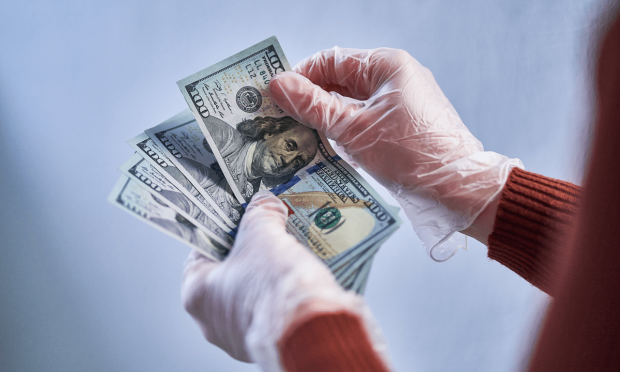Carrying Cash Could Become A Casualty Of COVID-19

While its imminent death has been long forecast, cash just keeps on living to pay another day. Cash may not be king in the U.S. market anymore, but reports of its demise have often proved to be a bit premature. U.S. consumers’ cash use has declined over the last several years in terms of its share of the overall payments pie, but as consumers spend more, the pie gets bigger, and as people continue to use cash, cash usage continues to grow.
And mostly for low dollar purchases. According to Federal Reserve Data, consumers opt for cash a little less than half the time (43 percent) when making a purchase of $10 or less.
At least before COVID-19, anyway.
Seventy-seven percent of those purchases were done face to face — which in a digital-first world and begs the question of how many of those transactions will truly become cashless.
Cleaning Up Dirty Money
While the term “dirty money” gets thrown around a lot, generally in connection to nefarious uses, the reality that has become increasingly clear in the era of a pandemic is that by nature of its physicality, cash is rife with unsanitary elements. U.S. currency is made out of a weave of cotton and linen that has turned out to be an exceptionally good surface for growing all kinds of bacteria. A 2017 study identified over 100 different strains of bacteria on dollar bills circulating in New York City. On an average pieces of currency one might expect to find Propionibacterium acnes, a bacteria known to cause acne, Streptococcus oralis, a common bacteria found in our mouths, Salmonella, pathogenic E.coli and methicillin-resistant Staphylococcus aureus (MRSA), which causes skin infections.
And those are just the common bugs. The study found all kinds of things on the bills — with food and drugs both being incredibly common. The food varied by neighborhood where the bills came from; the drug was mostly cocaine, traces of which could be found on almost 80 percent of dollar bills. Morphine, heroin, methamphetamine and amphetamine were also found to a lesser extent.
As of yet, no major disease outbreak has never been connected to the transfer of tainted bills, but public health officials are clearly worrying about it. Early in the outbreak in March, the World Health Organization (WHO) advised consumers worldwide against using cash and to use as many cashless options as possible to help contain the spread of the coronavirus.
“We know that money changes hands frequently and can pick up all sorts of bacteria and viruses,” a WHO spokesman said. “We would advise people to wash their hands after handling banknotes, and avoid touching their face. When possible, it would also be advisable to use contactless payments to reduce the risk of transmission.”
The Changing Consumer
It is a warning that consumers have been increasingly taking to heart. The pandemic has pushed them to digitize the majority of their offline lives into digital channels over the last eight months. According to the latest iteration of the PYMNTS and Visa How We Will Pay 2020 study cash usage has been hit hard — and is a fraction of what it used to be as the economy has rapidly pressed toward modernization and digitalization. That decline wasn’t created by the COVID-19 pandemic but it has been accelerated by it.
The PYMNTS study found that 80 percent of survey respondents adapt to new digital experiences due to a perception that they can reduce COVID-19 exposure by tapping into things like contactless commerce and avoiding cash. The study also found that the typical U.S. consumer currently goes to an ATM to get cash fewer than four times a year. And 11 percent fewer consumers carry cash now than did in 2018. The data also shows that 33 percent of consumers report factoring in payment options when selecting the merchant they will shop with, and the same amount report a preference for contactless card technologies for their in-store shopping experience. Twenty-six percent report favoring pre-payment within an app or website and receiving their goods delivered at curbside.
None of which is to say it’s time to declare cash totally dead. PYMNTS also found that there are places where cash is favored and prominent. Tipping in specific was such a behavior, with 48 percent of consumers reporting that tipping is the main reason they still carry cash. Moreover, PYMNTS data also found that when asked what payment method they wanted to power their connected commerce experiences, nearly a quarter (21 percent) reported cash was their main choice. For many consumers cash retains an important role. For all of its flaws, cash is a tangible measure of how much consumers actually have to spend — and how they can budget the cash on hand. Enveloping — putting cash in envelopes earmarked for savings or bill payments — is an attribute so important that many a FinTech has sought to replicate it in digital fashion.
Of course, the cash story is quite different in developing and emerging markets where cashless is a goal but very much a work in progress. Even in developed countries such as Germany, cash is a preferred payments type, and the sheer size of the economies in Africa, Latin America and Southeast Asia will make the shift away from cash to digital a long journey.
At the same time, central banks are exploring issuing their local currency in digital form — a big step closer to cashless — since the issuer of the currency will no longer do it in a physical form.
Although it might be early to declare cash dead across the board, there are new reasons that in the era of a pandemic, cash is looking especially unappetizing.
In fact, it seems fair to speculate cash will never quite recover from COVID-19 as consumers and governments find new ways to make cash digital.
